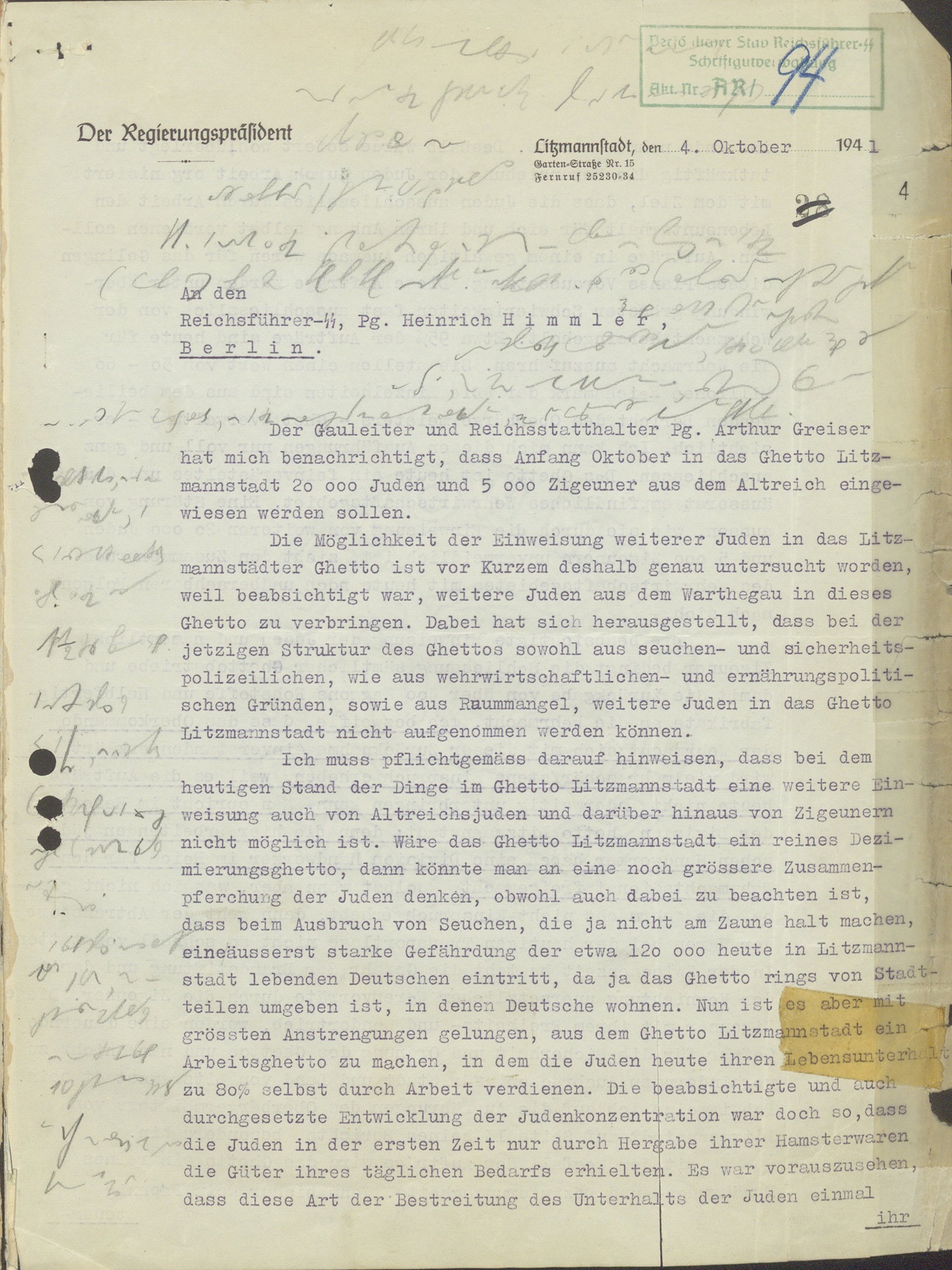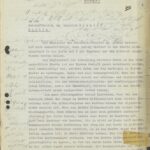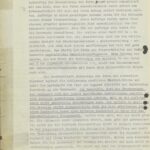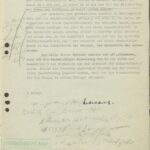Introduction
On October 4, 1941, the Government President of Litzmannstadt, Friedrich Uebelhoer, wrote to Reichsführer-SS Heinrich Himmler, addressing the planned transfer of “at least 20,000 Jews and 5,000 Gypsies” to the Litzmannstadt (Łódź) Ghetto. The letter explained the ghetto’s current capacity issues (“if the Litzmannstadt Ghetto were a pure extermination ghetto, then one could consider even greater crowding of the Jews”) and the potential risks to the surrounding German population. In the end, he declared that he “must decline responsibility for the consequences in full” if the deportations of additional Jews and the Sinti and Roma will be carried out.
Document
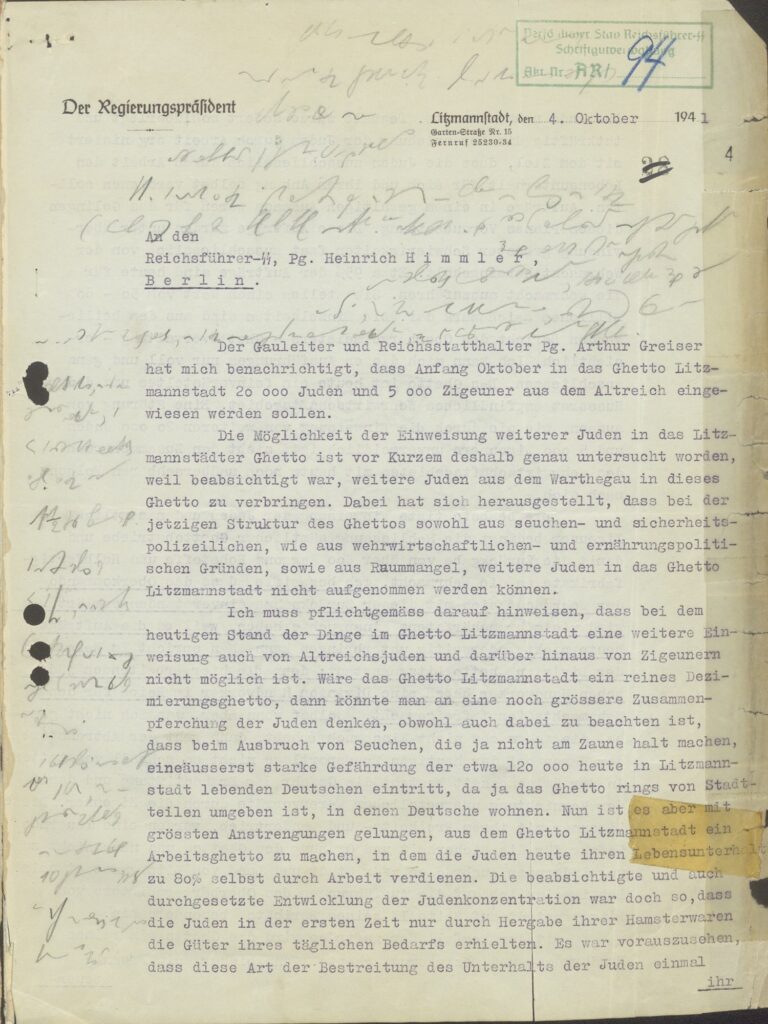
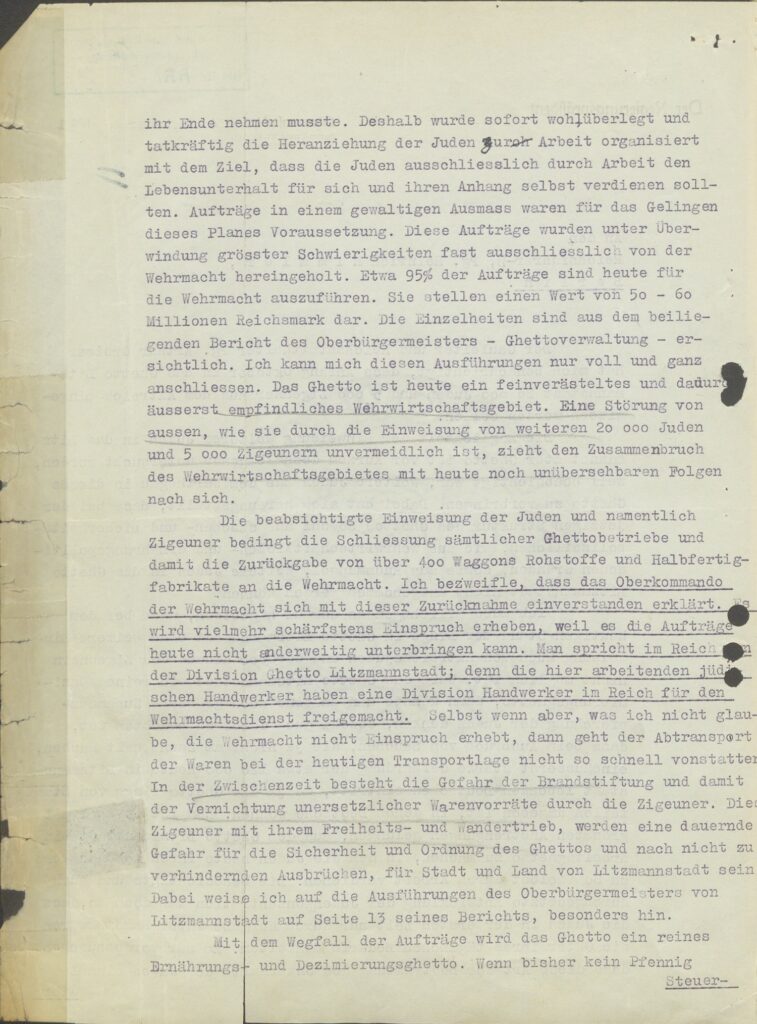
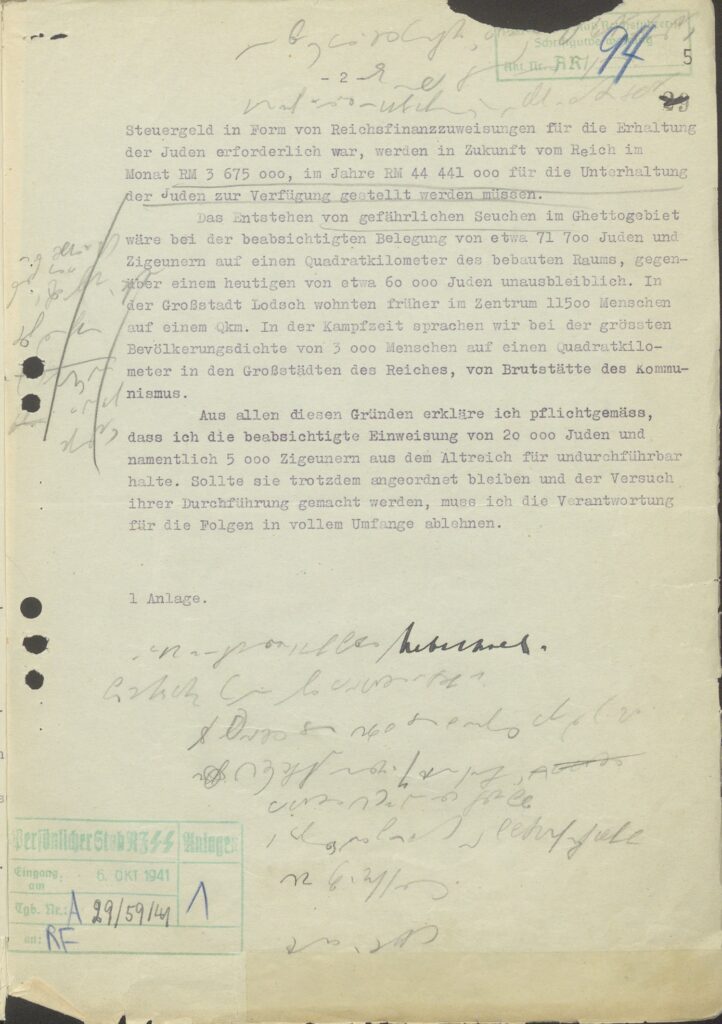
Der Regierungspräsident
Litzmannstadt, den 4. Oktober 1941
An den
Reichsführer-SS, Pg. Heinrich Himmler,
Berlin.
Der Gauleiter und Reichsstatthalter Pg. Arthur Greiser hat mich benachrichtigt, dass Anfang Oktober in das Ghetto Litzmannstadt 20 000 Juden und 5 000 Zigeuner aus dem Altreich eingewiesen werden sollen.
Die Möglichkeit der Einweisung weiterer Juden in das Litzmannstädter Ghetto ist vor Kurzem deshalb genau untersucht worden, weil beabsichtigt war, weitere Juden aus dem Warthegau in dieses Ghetto zu verbringen. Dabei hat sich herausgestellt, dass bei der jetzigen Struktur des Ghettos sowohl aus seuchen- und sicherheitspolizeilichen, wie auch aus nahrungswirtschaftlichen und ernährungspolitischen Gründen, sowie aus Raumangel, weitere Juden in das Ghetto Litzmannstadt nicht aufgenommen werden können.
Ich muss pflichtgemäß darauf hinweisen, dass bei dem heutigen Stand der Dinge im Ghetto Litzmannstadt eine weitere Einweisung auch von Altreichsjuden und darüber hinaus von Zigeunern nicht möglich ist. Wäre das Ghetto Litzmannstadt ein reines Dezimierungsghetto, dann könnte man an eine noch größere Zusammenpferchung der Juden denken, obwohl auch dabei zu beachten ist, dass beim Ausbruch von Seuchen, die ja nicht am Zaune halt machen, eine außerordentlich starke Gefährdung der etwa 120 000 heute in Litzmannstadt lebenden Deutschen eintritt, da ja das Ghetto rings von Stadtteilen umgeben ist, in denen Deutsche wohnen. Nun ist es aber mit größten Anstrengungen gelungen, in dem Ghetto Litzmannstadt ein Arbeitsghetto zu machen, in dem die Juden heute ihren Lebensunterhalt zu 80% selbst durch Arbeit verdienen. Dabei beabsichtigt auch der durchgreifende Entwicklung der Judenkonzentration war doch so, dass die Juden in der ersten Zeit nur durch Herabgabe ihrer Hamstervorräte sich über ihren täglichen Bedarfs erhielten. Es war vorauszusehen, dass diese Art der Bestreitung des Unterhalts der Juden einmal ihr Ende nehmen musste. Deshalb wurde sofort wohlüberlegt und tatkräftig die Heranziehung der Juden zur Arbeit organisiert mit dem Ziel, dass die Juden ausschliesslich durch Arbeit den Lebensunterhalt für sich und ihren Anhang selbst verdienen sollten. Aufträge in einem gewaltigen Ausmass waren für das Gelingen dieses Planes Voraussetzung. Diese Aufträge wurden unter Überwindung grösster Schwierigkeiten fast ausschliesslich von der Wehrmacht hereingeholt. Etwa 95% der Aufträge sind heute für die Wehrmacht auszuführen. Sie stellen einen Wert von 50 – 60 Millionen Reichsmark dar. Die Einzelheiten sind aus dem beiliegenden Bericht des Oberbürgermeisters – Ghettoverwaltung – ersichtlich. Ich kann mich diesen Ausführungen nur voll und ganz anschliessen. Das Ghetto ist heute ein feiner und äusserst empfindliches Wehrwirtschaftsgebiet. Eine Störung von aussen, wie sie durch die Einweisung von weiteren 20 000 Juden und 5 000 Zigeunern unvermeidlich ist, zieht den Zusammenbruch des Wehrwirtschaftsgebietes mit heute noch unübersehbaren Folgen nach sich.
Die beabsichtigte Einweisung der Juden und namentlich Zigeuner bedingt die Schliessung sämtlicher Betriebe und damit die Zurückgabe von über 40 Waggons Rohstoffe und Halbfertigfabrikate an die Wehrmacht. Ich bezweifle, dass das Oberkommando der Wehrmacht sich mit dieser Zurücknahme einverstanden erklärt wird vielmehr schärfstens Einspruch erheben, weil es die Aufträge heute nicht anderweitig unterbringen kann. Man spricht im Reich von der Division Ghetto Litzmannstadt; denn die hier arbeitenden jüdischen Handwerker haben eine Division Handwerker im Reich für den Wehrmachtsdienst freigemacht. Selbst wenn aber, was ich nicht glaube, die Wehrmacht nicht Einspruch erhebt, dann geht der Abtransport der Waren bei der heutigen Transportlage nicht so schnell vonstatten. In der Zwischenzeit besteht die Gefahr der Brandstiftung und damit der Vernichtung unersetzlicher Warenwerte durch die Zigeuner. Diese Zigeuner mit ihrem Freiheits- und Wandertrieb, werden eine dauernde Gefahr für die Sicherheit und Ordnung des Ghettos und nach nicht zu verhindernden Ausbrüchen, in Stadt und Land sein. Dabei weise ich auf die Ausführungen des Oberbürgermeisters von Litzmannstadt auf Seite 13 seines Berichtes, besonders hin.
Mit dem Wegfall der Aufträge wird das Ghetto ein reines Ernährungs- und Dezimierungsghetto. Wenn bisher kein Pfennig Steuergeld in Form von Reichsfinanzzuweisungen für die Erhaltung der Juden erforderlich war, werden in Zukunft vom Reich im Monat RM 3 675 000, im Jahre RM 44 441 000 für die Unterhaltung der Juden zur Verfügung gestellt werden müssen.
Das Entstehen von gefährlichen Seuchen im Ghettogebiet wäre bei der beabsichtigten Belegung von etwa 71 000 Juden und Zigeunern auf einen Quadratkilometer des bebauten Raums, gegenüber einem heutigen von etwa 60 000 Juden unausbleiblich. In der Großstadt Lodsch wohnten früher im Zentrum 11500 Menschen auf einem Qkm. In der Kampfzeit sprachen wir bei der grössten Bevölkerungsdichte von 3000 Menschen auf einen Quadratkilometer in den Großstädten des Reiches, von Brutstätte des Kommunismus.
Aus allen diesen Gründen erkläre ich pflichtgemäss, dass ich die beabsichtigte Einweisung von 20 000 Juden und namentlich 5 000 Zigeunern aus dem Altreich für undurchführbar halte. Sollte sie trotzdem angeordnet bleiben und der Versuch ihrer Durchführung gemacht werden, muss ich die Verantwortung für die Folgen in vollem Umfange ablehnen.
1 Anlage.
[Unterschrift]
The Government President
Litzmannstadt, October 4, 1941
To the
Reichsführer-SS, Pg. Heinrich Himmler,
Berlin.
The Gauleiter and Reich Governor Pg. Arthur Greiser has informed me that at the beginning of October, 20,000 Jews and 5,000 Gypsies from the Old Reich are to be admitted to the Litzmannstadt Ghetto.
The possibility of admitting additional Jews to the Litzmannstadt Ghetto was recently investigated because it was intended to transfer more Jews from the Warthegau to this ghetto. It has been found that with the current structure of the ghetto, further Jews cannot be admitted to the Litzmannstadt Ghetto due to health and security police reasons, as well as food supply and nutritional policy reasons, and also due to lack of space.
I must dutifully point out that under the current conditions in the Litzmannstadt Ghetto, further admission of Jews from the Old Reich and additionally of Gypsies is not possible. If the Litzmannstadt Ghetto were a pure extermination ghetto, then one could consider even greater crowding of the Jews, although it should also be noted that in the event of outbreaks of epidemics, which do not stop at the fence, there is an extremely strong risk to the approximately 120,000 Germans currently living in Litzmannstadt, as the ghetto is surrounded by areas of the city inhabited by Germans. However, it has been achieved with great effort to make the Litzmannstadt Ghetto a labor ghetto, where the Jews today earn their living 80% through work. It was also intended that the thorough development of the concentration of Jews would be such that the Jews initially survived by giving up their hoarded supplies. It was foreseeable that this way of sustaining the Jews would have to come to an end. Therefore, the employment of the Jews was immediately organized with careful planning and vigor, with the goal that the Jews should earn their livelihood exclusively through work for themselves and their dependents. Orders on a massive scale were essential for the success of this plan. These orders were procured almost exclusively from the Wehrmacht, overcoming great difficulties. About 95% of the orders today are for the Wehrmacht. They represent a value of 50 to 60 million Reichsmarks. The details can be seen from the attached report of the mayor – Ghetto administration. I can only fully and completely agree with these statements. The ghetto is today a fine and extremely sensitive economic area. Any disturbance from outside, as would be unavoidable by the admission of another 20,000 Jews and 5,000 Gypsies, would lead to the collapse of the economic area with consequences that are still unforeseeable today.
The intended admission of Jews and especially Gypsies necessitates the closure of all enterprises and thus the return of over 40 wagons of raw materials and semi-finished products to the Wehrmacht. I doubt that the High Command of the Wehrmacht will agree to this withdrawal and will rather raise the strongest objections, because it cannot accommodate the orders elsewhere today. People talk in the Reich about the Litzmannstadt Ghetto division; for the Jewish craftsmen working here have freed up a division of craftsmen in the Reich for Wehrmacht service. Even if, which I do not believe, the Wehrmacht does not object, the removal of the goods cannot proceed quickly given the current transport situation. In the meantime, there is a danger of arson and thus the destruction of irreplaceable goods by the Gypsies. These Gypsies, with their drive for freedom and wandering, will pose a constant threat to the security and order of the ghetto and, after inevitable escapes, will spread unchecked in town and country. I particularly refer to the remarks of the mayor of Litzmannstadt on page 13 of his report.
With the elimination of the orders, the ghetto will become a pure sustenance and extermination ghetto. If until now no penny of tax money in the form of Reich financial allocations for the maintenance of the Jews was necessary, in the future RM 3,675,000 per month and RM 44,441,000 per year will have to be provided by the Reich for the maintenance of the Jews.
The emergence of dangerous epidemics in the ghetto area would be inevitable with the intended occupancy of about 71,000 Jews and Gypsies on one square kilometer of built-up space, compared to the current approximately 60,000 Jews. In the city of Lodz, 11,500 people used to live in the center on one square kilometer. During the struggle period, we spoke of the highest population density of 3,000 people per square kilometer in the major cities of the Reich, as breeding grounds of communism.
For all these reasons, I must dutifully declare that I consider the intended admission of 20,000 Jews and particularly 5,000 Gypsies from the Old Reich to be impracticable. Should it still be ordered and an attempt made to carry it out, I must decline responsibility for the consequences in full.
1 Attachment.
[Signature]
Archivial reference:
Bundesarchiv, NS 19/2265
